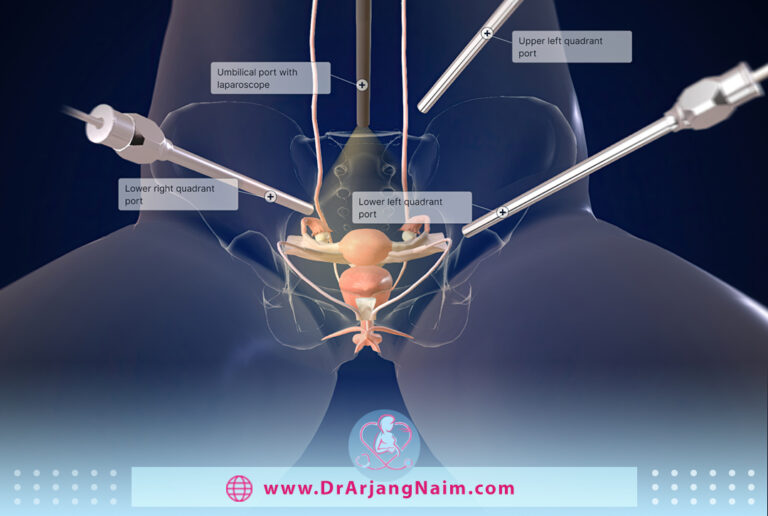An oophorectomy is a surgical procedure involving removing one or both ovaries in a woman. It’s performed for various reasons, such as treating or preventing cancer (ovarian, fallopian tube, or breast), addressing benign conditions like ovarian cysts or endometriosis, and regulating hormone levels, notably in hormonal disorders.
The surgery can be done through minimally invasive or open techniques. Still, it’s a significant decision due to its impact on hormone levels. It can induce surgical menopause, affecting bone health, cardiovascular health, and overall quality of life, especially for premenopausal women. The decision to undergo an oophorectomy should be made carefully, considering the potential benefits and risks with guidance from a healthcare professional.
What are the different types of oophorectomies?
There are several different types of oophorectomies. The surgeon will recommend one of the following based on your medical history and symptoms:
- Unilateral oophorectomy: removal of one ovary (one side).
- Bilateral oophorectomy: removal of both ovaries (both sides).
- Salpingo-oophorectomy: removal of one ovary and one fallopian tube
- Bilateral salpingo-oophorectomy: removal of the fallopian tubes and ovaries.
- Hysterectomy with salpingo-oophorectomy: removal of the uterus (hysterectomy) at the same time as removal of one fallopian tube and one ovary.
- Total hysterectomy with bilateral salpingo-oophorectomy: simultaneous removal of the uterus, cervix, fallopian tubes, and ovaries.
Why is an oophorectomy performed?
An oophorectomy is a surgical procedure in which one or both ovaries are removed. There are several medical reasons why an oophorectomy might be performed.
Ovarian cancer treatment or prevention
Oophorectomy is often performed as a treatment for ovarian cancer. If a woman is diagnosed with ovarian cancer, removing the affected ovary or ovaries can be part of the treatment plan. In some cases where a woman has a high risk of developing ovarian cancer due to genetic predisposition (e.g., BRCA gene mutations), preventive (prophylactic) oophorectomy might be recommended to reduce the risk of developing ovarian cancer.
Benign ovarian tumors
Noncancerous (benign) ovarian tumors, such as ovarian cysts or fibroids, can sometimes necessitate the removal of one or both ovaries.

Endometriosis
Severe endometriosis, a condition in which tissue similar to the lining of the uterus grows outside the uterus, can cause significant pain and discomfort. In cases where other treatments have been ineffective, removing the ovaries (and often the uterus, known as a total hysterectomy with bilateral salpingo-oophorectomy) can be a treatment option.
Chronic pelvic inflammatory disease (PID)
Chronic and severe cases of PID can lead to damage and infection of the ovaries, necessitating their removal.
Ovarian cysts
Large or persistent ovarian cysts that cause pain or other complications may require surgical removal of the affected ovary.
Ovarian torsion
Ovarian torsion is a painful condition in which the ovary twists on its ligament, cutting off its blood supply. Surgery to untwist the ovary or remove it may be necessary.
Hormone-related conditions
In certain hormone-related conditions, such as polycystic ovary syndrome (PCOS), where hormonal imbalances can cause various symptoms and complications, removing one or both ovaries may be considered in specific cases.
Transgender surgery
In gender-affirming surgeries for transgender individuals, an oophorectomy might be part of transitioning from male to female.

How to prepare for oophorectomy?
The surgeon will review the procedure with you and give any instructions for pre- and postoperative care. Ensure you understand the surgery risks, the expected recovery time, and how the procedure will be performed. Before planning surgery, your surgeon may ask you to have the following tests:
- Physical exam
- Blood tests
- Urine tests
- Ultrasound
- Magnetic resonance imaging (MRI)
How is an oophorectomy performed?
An oophorectomy is a surgical procedure involving removing one or both ovaries. The procedure can be performed using different surgical techniques, and the approach may vary based on the reason for the surgery, the patient’s overall health, and the surgeon’s expertise.
Laparoscopic oophorectomy (Minimally Invasive Surgery)
A laparoscopic oophorectomy is an operation to remove one or both of your ovaries, most commonly because of an ovarian cyst.
Procedure
This is the most common and minimally invasive approach. It involves making small incisions in the abdomen through which a laparoscope (a thin, lighted tube with a camera) and surgical instruments are inserted. The surgeon uses the laparoscope to guide the removal of the ovaries.
Advantages
Compared to traditional open surgery, there is less scarring, shorter hospital stays, quicker recovery, and reduced pain.
Recovery
Patients typically recover faster and experience less postoperative pain.
Laparotomy (open surgery)
A laparotomy is a surgical incision into the abdominal cavity.
Procedure
In an open surgery, a larger incision is made in the lower abdomen to access and remove the ovaries. The surgeon directly visualizes the organs and performs the removal.
Indications
Open surgery may be necessary for complex cases, extensive disease, or when laparoscopic surgery is not feasible or safe.
Recovery
Recovery time and postoperative pain are usually greater compared to laparoscopic surgery.
Robot-assisted laparoscopic oophorectomy
Surgical robotics is typically used in laparoscopy rather than open surgical approaches.
Procedure
This is similar to laparoscopic oophorectomy, but the surgeon uses a robotic surgical system to control the instruments with enhanced precision and flexibility.
Advantages
Enhanced dexterity, precision, and visualization compared to traditional laparoscopy.
Recovery
Recovery is similar to laparoscopic oophorectomy.
Salpingo-oophorectomy
In many cases, the removal of the ovaries is combined with the removal of the fallopian tubes (salpingectomy) for various medical reasons, including reducing the risk of ovarian and fallopian tube cancers.
Bilateral oophorectomy vs. unilateral oophorectomy
Bilateral oophorectomy involves removing both ovaries, while unilateral oophorectomy involves removing only one ovary. The choice depends on the medical condition and the surgeon’s recommendation.
Before the surgery, the patient will typically undergo preoperative evaluations, and the surgeon will discuss the surgical plan, risks, benefits, and potential alternatives. The choice of surgical approach will be based on factors such as the reason for the surgery, the patient’s health status, and the surgeon’s expertise. The patient needs to follow preoperative and postoperative instructions provided by the healthcare team for a successful recovery.
What are the risks of oophorectomy?
Oophorectomy, like any other surgery, carries risks. These can include the following:
- Blood clots
- Rupture of a malignant tumor, which can spread cancer cells
- Loss of fertility
- Severe pain caused by surgery or retaining ovarian cells
- Bad reaction to anesthesia
- Infection
- Injury to surrounding organs like bladder or bowel
- More bleeding than expected
Fertility and menopause after oophorectomy
The surgical removal of one or both ovaries can have significant implications for fertility and menopause in women.
Fertility after oophorectomy
If only one ovary is removed, the other ovary can still produce eggs and hormones, allowing for natural conception and pregnancy. Fertility may be slightly reduced due to losing one ovary, but many women can still conceive and have a healthy pregnancy.
Bilateral oophorectomy results in the loss of both ovaries, rendering a woman unable to conceive naturally. If a woman desires to have children after bilateral oophorectomy, options such as in vitro fertilization (IVF) with a surrogate or donated eggs may be considered.

Menopause after oophorectomy
If one ovary is removed, the remaining ovary can continue to produce estrogen and progesterone, delaying the onset of menopause. However, menopause may occur earlier than expected due to the loss of one ovary. Bilateral oophorectomy induces surgical menopause, as both ovaries are removed, the primary source of estrogen and progesterone.
Surgical menopause is typically abrupt and can lead to more intense and immediate menopausal symptoms compared to natural menopause, which occurs gradually. Women who undergo bilateral oophorectomy and enter surgical menopause may consider hormone replacement therapy (HRT) to manage menopausal symptoms and maintain bone health.
The bottom line
Oophorectomy can be a life-saving procedure in many cases. Bilateral prophylactic oophorectomy reduces the risk of ovarian and breast cancer in BRCA1 or BRCA2 carriers. However, people who do not have cancer risk markers should thoroughly discuss their options with their doctor, as surgery carries risks.
After surgery, recovery time can vary. It may take 4 to 6 weeks for a person to recover from surgery fully, but the overall outlook is positive. Open abdominal surgery usually has a longer recovery time than laparoscopic procedures. People who undergo bilateral oophorectomy may need a longer recovery than those who experience unilateral removal.
Doctors can help people explore recovery options and give them more information about what symptoms to expect after an oophorectomy.
Additional questions
- What are BRCA gene mutations?
BRCA gene mutations refer to alterations or changes in the BRCA1 and BRCA2 genes, which are human genes that produce proteins that help suppress the growth of tumors and regulate the repair of damaged DNA. These genes are often referred to as tumor suppressor genes.
- What are ovarian tumors?
Ovarian tumors are abnormal growths or masses in the ovaries, part of the female reproductive system. These tumors can be benign (noncancerous) or malignant (cancerous). Ovarian tumors can arise from various cell types within the ovaries, and they may have different characteristics, behaviors, and implications for a person’s health.
- What is magnetic resonance imaging used for?
Magnetic Resonance Imaging (MRI) is a versatile medical imaging technique used for a wide range of purposes, offering detailed and high-resolution images of the human body’s internal structures without ionizing radiation.
- Is an oophorectomy the same as a hysterectomy?
An oophorectomy is the surgical removal of one or both ovaries, the female reproductive organs that produce eggs and hormones. This procedure is performed for various reasons, such as addressing ovarian cancer, managing ovarian cysts, or dealing with hormone-related conditions. On the other hand, a hysterectomy involves the removal of the uterus, the organ where a fetus develops during pregnancy. Unlike oophorectomy, a hysterectomy does not always involve removing the ovaries. Both procedures are distinct in their focus and purpose, targeting different reproductive organs and serving different medical needs.
- What are the benefits of removing ovaries?
- Cancer Prevention and Risk Reduction
- Treatment of Existing Ovarian Cancer
- Management of Hormone-Related Conditions
- Reduction of Recurrent Ovarian Cysts
- Gender-Affirming Surgery
- Relief from Menopausal Symptoms
References
https://www.mayoclinic.org/tests-procedures/oophorectomy/about/pac-20385030
https://my.clevelandclinic.org/health/treatments/17800-oophorectomy
https://www.webmd.com/ovarian-cancer/ovaries-removal-surgery
https://www.healthdirect.gov.au/surgery/laparoscopic-oophorectomy
https://www.medicalnewstoday.com/articles/320555#outlook
https://www.healthline.com/health/womens-health/oophorectomy#outlook




